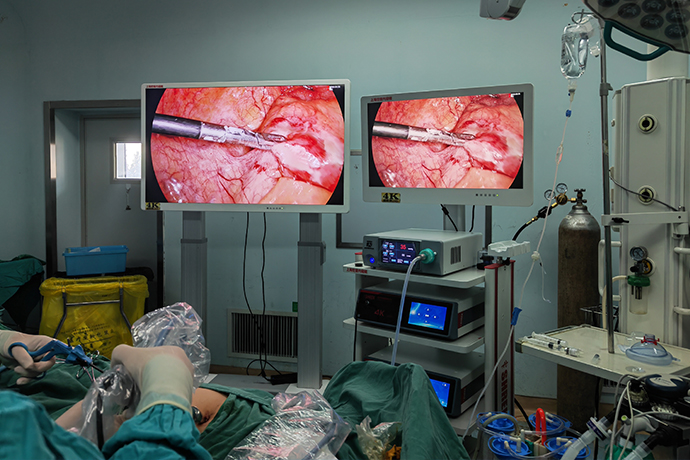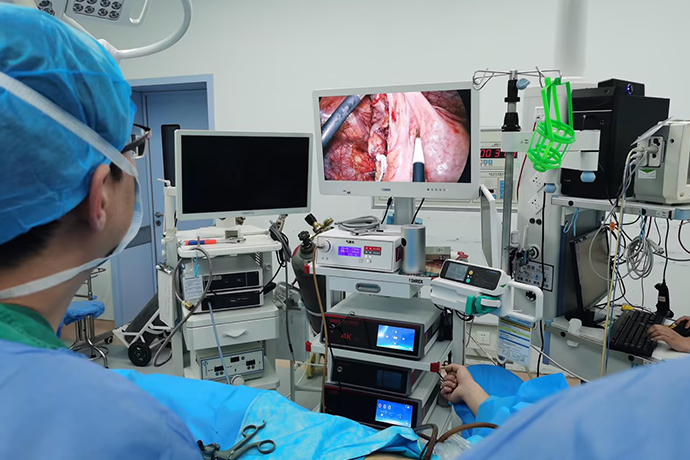[General Surgery Laparoscopy] 4K Ultra HD Laparoscopic Appendectomy
Release time: 26 Mar 2024 Author:Shrek
Generally speaking, compared with traditional surgery, laparoscopic surgery has the advantages of smaller incisions, less pain, faster recovery, and smaller postoperative scars. Laparoscopic appendicitis is a common general surgical operation and is relatively simple to treat. Appendicitis resection is mainly performed under laparoscopy. The operation of this operation is relatively simple. Laparoscopy is less harmful to the human body, causes less damage to body tissues, and has a good healing effect. So now many people choose to undergo laparoscopic surgery.

Whether it is chronic appendicitis or acute appendicitis, once it occurs, surgeons now generally recommend that patients undergo surgical removal of the appendix. In the past, the appendix was surgically removed, but now it is basically a minimally invasive surgery - laparoscopic appendectomy. Why choose laparoscopy to remove the appendix? In fact, the advantages of laparoscopic appendectomy are not only reflected in the incision, but also have advantages in the diagnosis, treatment and postoperative recovery of complex appendicitis.
Traditional surgery generally uses epidural anesthesia. An incision of about 75mm is made above the appendix in the right lower abdomen, and the patient enters the abdominal cavity and directly pulls out the appendix for removal. Due to the limitations of the incision, it is difficult to accurately grasp the situation in the abdominal cavity with the naked eye, and it is difficult to treat SARS. In this type of situation, once you encounter complicated appendicitis, you are often very passive. You must know that it is difficult to imagine what is going on inside until the belly is opened.
Advantages of Laparoscopic Appendectomy
1. Laparoscopic appendectomy has a wide field of view and can explore the entire abdominal cavity, which is not available in open surgery. Its surgical method has dual functions of diagnosis and surgery. Although laparoscopic appendectomy is performed without laparotomy, it can clarify the diagnosis of various pelvic or abdominal diseases, discover other combined lesions in the abdominal cavity, and avoid omissions. Other lesions (such as gastric cancer, colon cancer, small intestinal lesions, and lesions of the uterus and appendages in women).
2. There are very few complications in the wound and abdominal cavity. During laparoscopic appendectomy, there is no contact between the appendix and the surgical channel, and the abdominal cavity is filled with carbon dioxide gas, forming a high-pressure area, which avoids stimulation and contamination of the abdominal cavity by dust and bacteria in the air and keeps the abdominal cavity clean. The abdominal wall puncture replaces the abdominal wall incision, which avoids damage to the abdominal wall muscles, blood vessels and corresponding nerves. There will be no abdominal wall weakness and abdominal wall incisional hernia after the operation. The scarring of the abdominal wall muscles will not affect the motor function, nor will it be caused by the severing of the abdominal wall nerves. Corresponding skin numbness. Punch incision infection is far less likely than traditional incision infection or fat liquefaction, and wound infection and incisional hernia will almost never occur.
3. There are few abdominal adhesions, and adhesive intestinal obstruction generally does not occur after surgery. The incidence of intestinal adhesions in laparoscopic appendectomy is much lower than that in surgical appendectomy, which has been confirmed by many years of clinical observation. Laparoscopic surgery has little disturbance to the internal organs in the abdominal cavity. Ultrasonic scalpel is the main operation during the operation. The blood vessels of the appendix are first coagulated and then broken, resulting in less bleeding. The surgical field of view is wide, and thorough washing before the end of the operation can completely suck out the pus in the abdominal cavity caused by appendicitis. Therefore, the intestinal function recovers quickly after the operation and can be eaten earlier, which greatly reduces the factors of postoperative intestinal adhesions.
4. General anesthesia with tracheal intubation is used during the operation, and various intraoperative monitoring are complete, which greatly increases the safety of laparoscopic appendectomy.
5. The minimally invasive technical advantages of laparoscopic appendectomy include less pain after laparoscopic appendectomy, faster recovery, no restriction on sleeping positions, and the ability to turn over at will, which greatly reduces the patient's various postoperative discomforts. You can get out of bed and move around on the day of the surgery, eat the next day, and be discharged from the hospital in three to five days, which reduces the intensity of accompanying care from your family members. Laparoscopic appendectomy involves a small incision and leaves little to no scarring on the abdomen after recovery from surgery.
[Stamp card position]
Above the umbilicus: observation hole; anti-McFarland point: main operating hole; lower abdomen: secondary operating hole.
The supraumbilical or infraumbilical incision is the observation hole. For beginners, based on the best operating principle of a 60-degree angle, it is recommended to use the midpoint of the line connecting the umbilicus and the pubic symphysis as the auxiliary operating hole.
Just select a 5 mm Trocar. The lateral edge of the rectus abdominis on the right side of the umbilicus is the main operating hole. Use a 5 mm or 10 mm Trocar according to the situation. In this way, the main and auxiliary operating holes form a 60-degree angle with the appendix root, which is convenient for intraoperative operation and observation. , very friendly to beginners.
Female patients should pay attention to exploring the pelvic cavity and bilateral appendages to rule out related diseases.
Since each hospital has different operating habits, you are welcome to leave a message to add any deficiencies!

- Recommended news
- 【General Surgery Laparoscopy】Cholecystectomy
- Surgery Steps of Hysteroscopy for Intrauterine Adhesion
- [Gynecological Hysteroscopy] Techniques for Preventing and Treating Complications of Hysteroscopic Surgery
- [Gynecological Hysteroscopy] Hysteroscopic Adhesiolysis
- [Gynecological Hysteroscopy] IUD Removal under Hysteroscopy